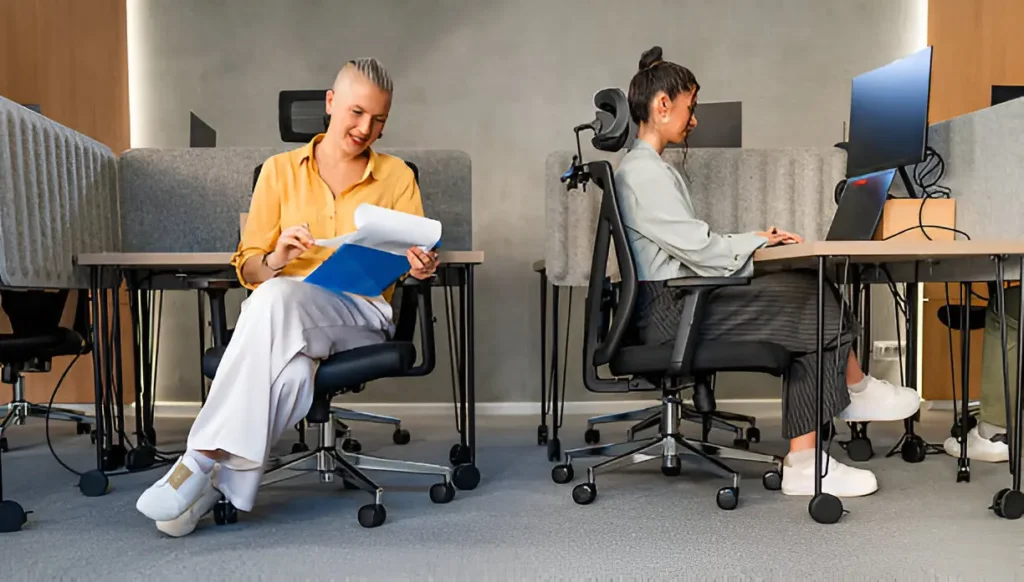The contemporary professional environment is increasingly recognising the importance of employee well-being, which extends beyond health insurance and fitness benefits to include the very furniture employees interact with daily. The centerpiece of this evolution is the ergonomic revolution in office seating. Ergonomic seating not only provides comfort but also caters to productivity and long-term health benefits for workers who spend extensive periods at their desks. This marks the significant rise in the deployment of ergonomic office chairs within the workspace.
The Need for Ergonomic Seating
Traditional office chairs often failed to address the wide array of discomforts experienced by individuals in a seated position for the better part of their workday. The emergence of ergonomic seating solutions springs from the increased awareness of the health implications linked with poor posture and prolonged sitting. It encompasses a design philosophy tailored to support the body comfortably, reduce strain on the muscles and skeletal system, and to promote good posture.
Key Features of Ergonomic Chairs
Ergonomic chairs stand out by incorporating features such as adjustable seat height, lumbar support, and flexible backrests, all aimed at promoting proper alignment and comfort. Additional features may include adjustable armrests, headrests, and the ability for the chair to swivel and move effortlessly, minimising the need to strain when reaching for objects or turning around.
Health Benefits
There are substantial health benefits attached to the use of ergonomic office chairs. Firstly, they significantly reduce the risk of developing back pain, one of the most common workplace ailments. Proper lumbar support in conjunction with a design that encourages dynamic sitting can alleviate pressure on the spine and reduce the likelihood of muscle fatigue.
Moreover, the adaptability of ergonomic chairs to an individual’s body shape helps to minimise pressure points and promote blood circulation, which is particularly important for those who sit for long periods. Enhanced comfort levels also have a direct correlation to increased concentration and productivity.
Productivity Enhancement
The comfort provided by ergonomic seating directly contributes to an employee’s ability to remain focused and productive. Well-designed chairs prevent discomfort that can lead to frequent breaks and distractions. Furthermore, proper support and posture reduce the energy expenditure used for maintaining body position, allowing more energy to be channelled towards work-related tasks.
Adopting Ergonomic Chairs in the Workplace
For businesses looking to invest in their workforce’s health and productivity, the addition of ergonomic office chairs is a prudent decision. It signals a commitment to employee well-being and fosters a work environment conducive to performance. It is an investment that goes a long way in reducing workplace injury, diminishing absenteeism related to musculoskeletal disorders, and heightening job satisfaction.
Cost Implications and Returns
While the upfront cost of ergonomic chairs may be higher than traditional seating, the long-term savings in healthcare costs, worker compensation, and improved employee productivity provide a compelling return on investment. Businesses often find that the initial expenditure is offset by the cumulative benefits over time.
Implementation Strategies
When integrating ergonomic seating solutions, it is crucial for companies to consider individual needs. Employees come in all shapes and sizes, and a one-size-fits-all approach is less effective. Tailoring chair selections and providing education on proper usage can ensure maximum benefit.
The Future of Ergonomic Office Chairs
The future of ergonomics in workplace design is bright, and ergonomic office chairs are at the forefront. Advances in materials and technology are continuously enhancing the comfort, support, and functionality provided by these chairs. Neural ergonomics, which focuses on cognitive function and reducing mental fatigue, is increasingly being considered in chair design. As more research highlights the link between physical comfort and cognitive performance, ergonomic office chairs will continue to evolve to meet these needs.
Ergonomics in Remote Work
The rise of remote work has further amplified the need for well-designed ergonomic office chairs. Home offices are becoming permanent fixtures in many professionals’ lives, making the need for comfortable, supportive seating more prevalent than ever. Individuals are recognising the necessity to invest in their health and productivity by choosing ergonomic solutions for their home workspaces as well.
Sustainability and Ergonomics
Ergonomic office furniture is also aligning with sustainability efforts. Manufacturers are increasingly focusing on using recyclable materials and sustainable production practices. This not only benefits the environment but also resonates with consumers who are ever more conscious of the ecological footprint of their purchases.
Conclusion
The current trajectory of office furniture design illustrates a clear transition from passive seating to active support. Ergonomic office chairs represent an investment in the health and efficiency of the workforce, and their rise in the workplace is a testament to their value. They are not merely a fad but a continuing trend backed by positive outcomes for employees and employers alike. As we move forward, the importance of ergonomic seating cannot be overstated; it is a critical component in crafting a workplace that is healthy, productive, and comfortable.
Also Read-Becoming Stronger Through Life’s Challenges


